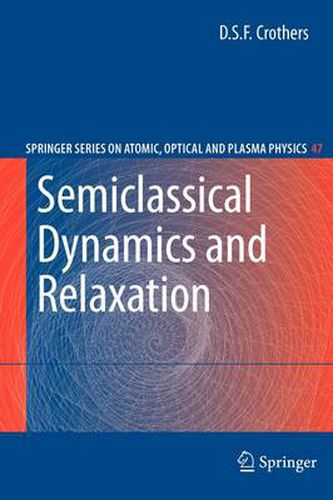Readings Newsletter
Become a Readings Member to make your shopping experience even easier.
Sign in or sign up for free!
You’re not far away from qualifying for FREE standard shipping within Australia
You’ve qualified for FREE standard shipping within Australia
The cart is loading…






This title is printed to order. This book may have been self-published. If so, we cannot guarantee the quality of the content. In the main most books will have gone through the editing process however some may not. We therefore suggest that you be aware of this before ordering this book. If in doubt check either the author or publisher’s details as we are unable to accept any returns unless they are faulty. Please contact us if you have any questions.
Condensed-matter physics plays an ever increasing role in photonics, electronic and atomic collisions research. Dispersion (Dynamics and Relaxation) includes scattering/collisions in the gaseous phase. It also includes thermal agitation, tunneling and relaxation in the liquid and solid phases. Classical mechanics, classical statistical mechanics, classical relativity and quantum mechanics are all implicated. ‘Semiclassical’ essentially means that there is a large or asymptotic real parameter. ‘Semiclassical’ can also mean ‘classical with first-order quantal correction’, based on an exponentiated Liouville series commencing with a simple pole in the -plane, being Planck’s reduced constant and coming with all the attendant connection problems associated with the singularity at the turning or transition point and with the Stokes phenomenon. Equally,‘ semiclassical’ can mean ‘electrons described quantally and the heavy particles classically’. This latter gives rise to the so-called impact parameter method based on a pre-assigned classical trajectory.
With evermore sophisticated experiments, it has become equally more important to test theory over a wider range of parameters. For instance, at low impact energies in heavy-particle collisions, the inverse velocity is a large parameter; in single-domain ferromagnetism, thermal agitation (including Brownian motion and continuous-time random walks) is faced with a barrier of height ‘sigma’, a possibly large parameter. Methods of solution include phase-integral analysis, integral transforms and change-of-dependent variable. We shall consider the Schroedinger time-independent and time-dependent equations, the Dirac equation, the Fokker Planck equation, the Langevin equation and the equations of Einstein’s classical general relativity equations.
There is an increasing tendency among physicists to decry applied mathematics and theoretical physics in favour of computational blackboxes. One may say applied mathematics concerns hard sums and products (and their inverses) but unless one can simplify and sum infinite series of products of infinite series, can one believe the results of a computer program? The era of the polymath has passed; this book proposal aims to show the relevance to, and impact of theory on, laboratory scientists.
$9.00 standard shipping within Australia
FREE standard shipping within Australia for orders over $100.00
Express & International shipping calculated at checkout
Stock availability can be subject to change without notice. We recommend calling the shop or contacting our online team to check availability of low stock items. Please see our Shopping Online page for more details.
This title is printed to order. This book may have been self-published. If so, we cannot guarantee the quality of the content. In the main most books will have gone through the editing process however some may not. We therefore suggest that you be aware of this before ordering this book. If in doubt check either the author or publisher’s details as we are unable to accept any returns unless they are faulty. Please contact us if you have any questions.
Condensed-matter physics plays an ever increasing role in photonics, electronic and atomic collisions research. Dispersion (Dynamics and Relaxation) includes scattering/collisions in the gaseous phase. It also includes thermal agitation, tunneling and relaxation in the liquid and solid phases. Classical mechanics, classical statistical mechanics, classical relativity and quantum mechanics are all implicated. ‘Semiclassical’ essentially means that there is a large or asymptotic real parameter. ‘Semiclassical’ can also mean ‘classical with first-order quantal correction’, based on an exponentiated Liouville series commencing with a simple pole in the -plane, being Planck’s reduced constant and coming with all the attendant connection problems associated with the singularity at the turning or transition point and with the Stokes phenomenon. Equally,‘ semiclassical’ can mean ‘electrons described quantally and the heavy particles classically’. This latter gives rise to the so-called impact parameter method based on a pre-assigned classical trajectory.
With evermore sophisticated experiments, it has become equally more important to test theory over a wider range of parameters. For instance, at low impact energies in heavy-particle collisions, the inverse velocity is a large parameter; in single-domain ferromagnetism, thermal agitation (including Brownian motion and continuous-time random walks) is faced with a barrier of height ‘sigma’, a possibly large parameter. Methods of solution include phase-integral analysis, integral transforms and change-of-dependent variable. We shall consider the Schroedinger time-independent and time-dependent equations, the Dirac equation, the Fokker Planck equation, the Langevin equation and the equations of Einstein’s classical general relativity equations.
There is an increasing tendency among physicists to decry applied mathematics and theoretical physics in favour of computational blackboxes. One may say applied mathematics concerns hard sums and products (and their inverses) but unless one can simplify and sum infinite series of products of infinite series, can one believe the results of a computer program? The era of the polymath has passed; this book proposal aims to show the relevance to, and impact of theory on, laboratory scientists.